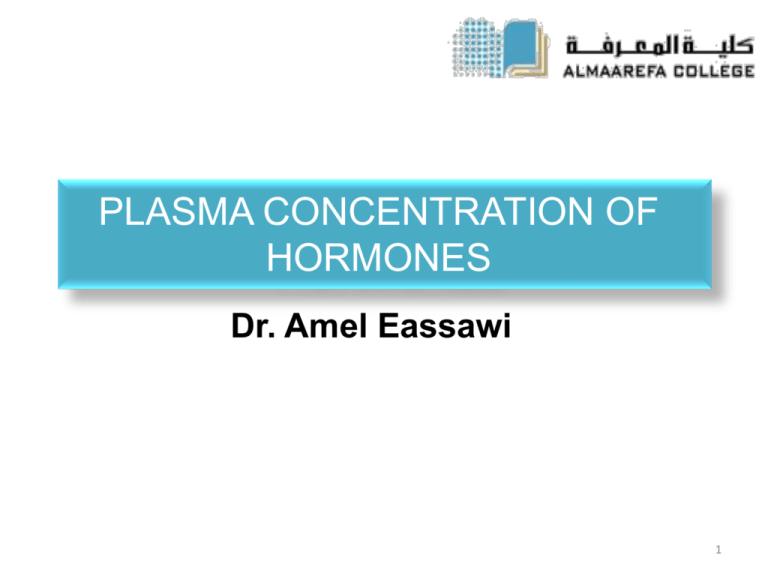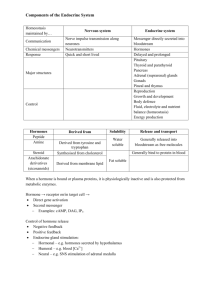PLASMA CONCENTRATION OF HORMONES
advertisement

PLASMA CONCENTRATION OF HORMONES Dr. Amel Eassawi 1 OBJECTIVES The Student Should be able to: Explain the factors that influence the plasma concentrations of hormones. Recognizing the different types of hormone interactions and the significance of hormone concentrations. Explain the principles of positive and negative feedback control of hormone secretion. Explain the effects of secretion, excretion, degradation, and volume of distribution on the concentration of a hormone in blood plasma. List hormone measurements assays. Identifying the most common causes of endocrine dysfunctions. PLASMA CONCENTRATION OF HORMONE The effective plasma concentration of a hormone depends on: 1. The rate of secretion into the blood by the endocrine gland. 2. The rate of metabolic activation or conversion. Example: T4 to T3 or conversion of small amount of testosterone to estrogen. 3. The extent of binding to plasma proteins (lipophilic hormones). Example during pregnancy the level of thyroid hormone is high even with normal thyroid function. 4. The rate of removal from the blood by metabolic inactivation and excretion in the urine. The effective plasma concentration of a hormone is normally regulated by changes in the rate of its secretion. CONTROL OF HORMONE SECRETION Rate of secretion of hormone depends on: 1. Negative feed back control 2. Neuroendocrine reflexes 3. Circadian and Diurnal Rhythm Negative Feedback Control: Negative feedback exists when the output of a system counteracts a change in input, maintaining a controlled variable within a narrow range around a set level. Neuroendocrine Reflex: Sudden increase in hormone secretion in response to a specific stimulus. Control system involve both neural and endocrine factor. Example secretion of epinephrine is controlled by sympathetic nervous system. 4 CONTROL OF HORMONE SECRETION 1. Diurnal Rhythm Day–night Example increase Prolactin secretion during night. 2. Circadian Rhythm circadian (“around a day”) rhythm, which is characterized by repetitive oscillations in hormone levels that are very regular and cycle once every 24 hours. Example Cortisol 3. Sleep Wake Rhythm Example Infants / Children increase GH during sleep increase ACTH and Cortisol during sleep 4. Infradian Rhythm Ovarian steroids – Estrogen & Progesterone 5. Developmental Rhythm Example Growth Rhythm 6. Ultradian Rhythm -moment to moment change Example insulin 5 CONTROL OF HORMONE SECRETION Feedback Loops 6 CIRCADIAN RHYTHM 7 CIRCADIAN RHYTHM 8 CIRCADIAN/DIURNAL PATTERNS AND THE LIFE CYCLE Steiger et al., . (J Int Med. 254: 13-22, 2003) Luboshitzky et al., (J. Clinical Endocrinol Metab. 88: 3160-3166, 2003) Right panel: Arrows indicate 1st onset of REM sleep. ULTRADIAN OSCILLATIONS INFRADIAN RHYTHM Adapted from Santoro et al, (Journal of Clinical Endocrinology and Metabolism, 81: 1495–1501, 1996) NEUROENDOCRINE REFLEX 12 REGULATION OF HORMONE RECEPTORS Down Regulation: A mechanism in which a hormone decreases the number or affinity of its receptors in a target tissue. Down-regulation may occur by decreasing the synthesis of new receptors, by increasing the degradation of existing receptors, or by inactivating receptors. Up Regulation: A mechanism in which a hormone increases the number or affinity of its receptors. Up-regulation may occur by increasing synthesis of new receptors, decreasing degradation of existing receptors, or activating receptors. 13 RESPONSIVENESS OF TARGET CELL TO HORMONE HORMONE CLEARANCE FROM BLOOD The rate of removal of the hormone from the blood which is called the metabolic clearance rate occurs by: – metabolic destruction by the tissues. – binding with the tissues. – excretion by the liver into the bile. – excretion by the kidneys into the urine. HORMONE CLEARANCE FROM BLOOD Lipophilic hormones are bound to plasma proteins so free hormone available is less to the tissues Rate of Removal of Hormone: Hydrophilic hormones are easily inactivated by blood and tissue enzyme. Remains in blood for (few minutes to few hours) Lipophilic hormones are found in a bound form in the blood. They are less susceptible to enzymatic inactivation. Hormones remain in blood for larger time few hours (steroids) and weeks (thyroid hormone). Patients with liver & kidney disease may suffer from excess of hormone activity. 16 HORMONE MEASUREMENT • Bioassay • Chemical assay • Immunoassay – important for diagnosis of endocrine-related diseases, determining metabolic clearance rate and pattern of hormone secretion. SYNERGISTIC EFFECTS OF HORMONES PERMISSIVENESS, SYNERGISM, AND ANTAGONISM Permissiveness: one hormone must be present in adequate amounts for the full exertion of another hormone’s effect. thyroid hormone increases the number of receptors for epinephrine in epinephrine’s target cells. Synergism: occurs when the actions of several hormones are complementary and their combined effect is greater than the sum of their separate effects Presence of FSH & Testosterone for effective spermatogenesis. Antagonism: occurs when one hormone causes the loss of another hormone’s receptors, reducing the effectiveness of the second hormone Progesterone (a hormone secreted during pregnancy that decreases contractions of the uterus) inhibits uterine responsiveness to 19 estrogen. ENDOCRINE DISEASES • • • • Hormone Overproduction Hormone Underproduction Altered Tissue Responses Tumors of Endocrine Glands HYPOSECRETION • Primary hyposecretion: occurs when an endocrine gland is secreting too little of its hormone because of an abnormality within that gland • Secondary hyposecretion: takes place when an endocrine gland is normal but is secreting too little hormone because of a deficiency of its tropic hormone. Primary hyposecretion: genetic (inborn absence of an enzyme that catalyzes synthesis of the hormone, such as the inability to synthesize cortisol because of the lack of a specific enzyme in the adrenal cortex. HYPOSECRETION • Dietary (lack of iodine, which is needed for synthesis of thyroid hormone). • Chemical or toxic (certain insecticide residues may destroy the adrenal cortex). • Immunologic (autoimmune antibodies may destroy the body’s own thyroid tissue). • Other disease processes (cancer or tuberculosis may coincidentally destroy endocrine glands). • Iatrogenic (physician induced, such as surgical removal of a cancerous thyroid gland). • Idiopathic (meaning the cause is not known). HYPERSECRETION • Primary hypersecretion – When the defect lies within the gland itself • Secondary hypersecretion – Results from excessive stimulation from the outside • Tumor • Immunological defect - excessive stimulation of the thyroid gland by an abnormal antibody that mimics the action of TSH, the thyroid tropic hormone. • Substance abuse - athletes of using certain steroids that increase muscle mass by promoting protein synthesis in muscle cells 24 Table 18-1, p. 665 REFERENCES Human physiology, Lauralee Sherwood, seventh edition. Text book physiology by Guyton &Hall,11th edition. Physiology by Berne and Levy, sixth edition.







